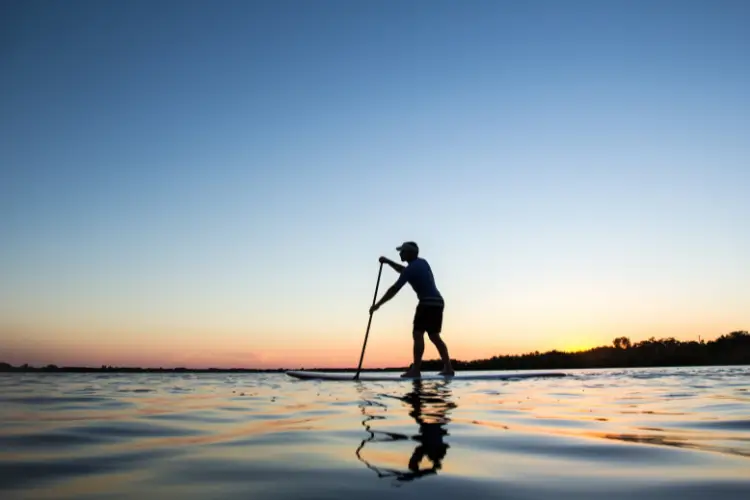Prone paddleboarding is becoming a popular water sport, offering excitement and challenge to both beginners and seasoned enthusiasts. Unlike stand-up paddleboarding, prone paddleboarding involves lying flat on the board and using your hands to paddle through the water. This unique form of paddling requires attention to technique for both safety and a fun experience. Learning the right methods can greatly enhance your time on the water, helping you to stay safe, avoid fatigue, and enjoy the ride to the fullest. With its rising interest, prone paddleboarding is certainly an activity to explore. In this article, we’ll look at some common mistakes to avoid, ensuring that your paddleboarding journey remains pleasant.
Choosing the Right Prone Paddleboard
Selecting the right prone paddleboard is a crucial step for a rewarding experience. Here are some key factors to consider:
- Size: The size of your board can affect stability and speed. Larger boards offer more stability, which is beneficial for beginners. In contrast, smaller boards are faster but require more skill to handle.
- Shape: Different shapes suit different water conditions. For instance, a pointed nose can cut through choppy water more effectively, while a rounded nose might be better for calm conditions.
- Material: The material of the paddleboard determines its durability and weight. Options like fiberglass provide a balance of weight and strength, whereas more advanced options may include carbon fiber, offering lightweight performance for skilled riders.
While price might be a consideration, prioritize these attributes to ensure that your board fits your needs. Investing in the right board can significantly impact your enjoyment and performance on the water. For a deeper understanding, explore the A-Z Paddleboard selection guide from Paddleboard Insiders.
By considering these elements, you can avoid the mistake of incorrectly choosing a board, which could hinder your paddleboarding experience. Make informed decisions to enhance your adventures and grow in the sport.
Understanding Prone Paddleboard Techniques
Mastering the basics of prone paddleboarding is essential for a safe and enjoyable experience. Utilizing proper techniques can make a big difference in your performance and safety.
Essential Techniques:
- Paddling: Effective paddling involves using your arms to propel yourself through the water. Keep your hands cupped and use a smooth, rhythmic motion.
- Balancing: Distribute your weight evenly on the board. This aids stability and helps maintain a straight path in the water.
Consequences of Poor Technique:
- Reduced Efficiency: Improper techniques can slow you down and cause fatigue.
- Safety Risks: Mismanaged techniques increase the risk of accidents.
To refine your skills, consider taking paddleboarding classes or watching online tutorials. These resources provide structured guidance on improving your technique. Additionally, you may find helpful insights from this Paddleboard guide by Expert Advice.
Avoiding Improper Posture
Maintaining the right posture while prone paddling is key to both comfort and efficiency.
Ideal Posture:
- Head Position: Keep your head up to see where you’re going without straining your neck.
- Core Engagement: Engage your core muscles to help balance and maneuver the board.
- Leg Positioning: Keep your legs relaxed and slightly apart for stability.
Risks of Bad Posture:
- Injury: Poor posture can lead to shoulder and neck strain.
- Fatigue: Bad posture often results in quicker fatigue.
To enhance your posture and core strength, incorporate the following tips:
- Exercises: Engage in exercises that focus on core strength, such as planks and side planks.
- Practices: Consider yoga or Pilates for improving flexibility and muscle tone.
By understanding these fundamentals and applying them, you’ll significantly improve your efficiency and enjoyment. Don’t hesitate to make use of external resources such as classes, tutorials, and professional advice to boost your abilities on the water.
Weather and Water Condition Awareness
Understanding the weather and water conditions is crucial before you head out on a prone paddleboard. Being aware can keep you safe and make your experience more enjoyable. Here’s what to keep in mind:
- Check Forecasts: Always look at the weather forecast before going out. Avoid days with high winds, strong currents, or storms. Websites like NOAA provide reliable forecasts.
- Understand Water Conditions: Water conditions can change rapidly. Calm waters are ideal for beginners. Check for tide schedules and be wary of any advisories in your local area. A trusted site like Marine.weather.gov can offer detailed insights.
- Safety Hazards: Not checking these conditions can lead to dangerous situations, such as getting caught in unexpected waves or adverse weather. Proper awareness can prevent accidents and ensure a safer paddleboarding experience.
- Prepare Accordingly: Depending on the conditions, dress appropriately. This might mean wearing a wetsuit if it’s cold or ensuring you have sun protection on sunny days.
- Know Your Limits: If conditions seem uncertain or beyond your ability, it’s best to wait for a better day. Prioritize safety over adventure every time.
Using Gear and Safety Equipment Properly
Having the right gear and knowing how to use it correctly can make all the difference in prone paddleboarding, ensuring both safety and comfort.
- Essential Gear:
- Leash: Keeps your board close if you fall off.
- Wetsuit: Provides warmth and protection in cooler waters.
- Personal Flotation Device (PFD): Essential for safety, helping you stay afloat in emergencies.
- Common Dangers:
- Not using a leash can result in drifting away from your board.
- Skipping safety equipment significantly increases the risk of drowning or hypothermia.
- Equipment Checks:
- Inspect your gear regularly for any signs of wear or damage.
- Replace faulty equipment promptly to ensure it functions when needed.
- Proper Usage:
- Always secure your leash and wear your PFD properly.
- Ensure wetsuits fit well to maximize their insulative qualities.
Remember, ensuring that you’re well-prepared with the right equipment not only enhances the fun but is essential for your safety on the water.
Guidelines for Buying a Prone Paddleboard for Sale
Buying a prone paddleboard is an exciting step, but it’s important to make an informed decision whether you’re going for a new or used board. Here’s what you need to know:
- Inspect the Board Thoroughly: If you are considering a used prone paddleboard for sale, check for any signs of damage or repairs. Common areas of concern include the surface, edges, and any visible cracks or dents.
- Ask Important Questions: When buying, inquire about the board’s history, such as how often it was used and where it was stored. Knowing its past can give you insight into its condition.
- Don’t Skip a Trial Run: If possible, test the paddleboard on water. This will help you get a feel for its stability and performance and help you decide if it’s the right fit.
- Consider Key Buying Factors: Consider key factors such as size, shape, and material that impact your paddling experience. For a detailed understanding, refer to the section on selecting the right paddleboard.
- Where to Find Boards: Check online marketplaces, local sporting goods stores, and water sports events. Ensure the seller is reputable to avoid any surprises.
Tips for Beginners Trying Prone Paddleboarding
Starting prone paddleboarding can be both thrilling and a bit challenging. Here are some practical tips for beginners:
- Start in Calm Waters: Begin in areas with gentle conditions to help build confidence without overwhelming waves.
- Practice with Friends: Having a buddy not only makes the experience more fun but also safer.
- Familiarize Yourself with the Board: Spend some time on land getting used to the board’s balance and paddling motion before diving in.
- Avoid Common Beginner Mistakes: These include poor posture and neglecting to check weather conditions before heading out.
- Find Beginner-Friendly Spots: Seek out local clubs or locations known for being accommodating to new paddleboarders.
By following these tips and avoiding common mistakes, you’ll have a better and safer experience while riding a prone paddleboard. Remember to always prioritize your safety and make informed decisions when it comes to your equipment and techniques. Happy paddleboarding!




